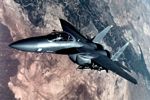
original at www.af.mil |
F-15E
(U.S. Air Force Photo)
The F-15 Eagle is an all-weather, extremely maneuverable, tactical fighter designed to gain and maintain air superiority in aerial combat. |
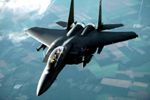
original at www.af.mil |
F-15E Strike Eagle
(U.S. Air Force photo)
The Eagle's air superiority is achieved through a mixture of unprecedented maneuverability and acceleration, range, weapons and avionics. It can penetrate enemy defense and outperform and outfight any current or projected enemy aircraft. The F-15 has electronic systems and weaponry to detect, acquire, track and attack enemy aircraft while operating in friendly or enemy-controlled airspace. |
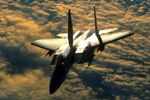
original at www.af.mil |
F-15C flying at sunset
(U.S. Air Force photo by Master Sgt. Dave Nolan)
The F-15 Eagle is an all-weather, extremely maneuverable, tactical fighter designed to gain and maintain air superiority in aerial combat. The single-seat F-15C and two-seat F-15D models entered the Air Force inventory beginning in 1979. Kadena Air Base, Japan, received the first F-15C in September 1979. These new models have Production Eagle Package (PEP 2000) improvements, including 2,000 pounds (900 kilograms) of additional internal fuel, provision for carrying exterior conformal fuel tanks and increased maximum takeoff weight of up to 68,000 pounds (30,600 kilograms). |
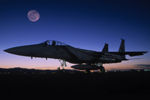
original at www.af.mil |
F-15 at moonrise
(U.S. Air Force photo by Airman 1st Class William Fallin)
The F-15 Eagle is an all-weather, extremely maneuverable, tactical fighter designed to gain and maintain air superiority in aerial combat. The Eagle's air superiority is achieved through a mixture of unprecedented maneuverability and acceleration, range, weapons and avionics. It can penetrate enemy defense and outperform and outfight any current or projected enemy aircraft. The F-15 has electronic systems and weaponry to detect, acquire, track and attack enemy aircraft while operating in friendly or enemy-controlled airspace. Its weapons and flight control systems are designed so one person can safely and effectively perform air-to-air combat. |

original at www.af.mil |
F-15C Goes Vertical
(U.S. Air Force photo by Senior Amn Brett Snow)
The F-15 Eagle is an all-weather, extremely maneuverable, tactical fighter designed to gain and maintain air superiority in aerial combat. The Eagle's air superiority is achieved through a mixture of unprecedented maneuverability and acceleration, range, weapons and avionics. It can penetrate enemy defense and outperform and outfight any current or projected enemy aircraft. The F-15 has electronic systems and weaponry to detect, acquire, track and attack enemy aircraft while operating in friendly or enemy-controlled airspace. Its weapons and flight control systems are designed so one person can safely and effectively perform air-to-air combat. |
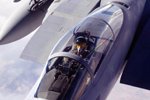
original at www.af.mil |
F-15C Eagle is refueled
(U.S. Air Force photo)
The F-15 Eagle is an all-weather, extremely maneuverable, tactical fighter designed to gain and maintain air superiority in aerial combat. The Eagle's air superiority is achieved through a mixture of unprecedented maneuverability and acceleration, range, weapons and avionics. It can penetrate enemy defense and outperform and outfight any current or projected enemy aircraft. The F-15 has electronic systems and weaponry to detect, acquire, track and attack enemy aircraft while operating in friendly or enemy-controlled airspace. Its weapons and flight control systems are designed so one person can safely and effectively perform air-to-air combat. |
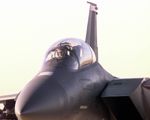
original at www.af.mil |
U.S. forces again strike Iraqi missile site
(U.S. Air Force photo by Staff Sgt. Vincent Parker)
An F-15E Strike Eagle taxis at Incirlik Air Base, Turkey, Dec. 30 before a sortie in support of Operation Northern Watch. |
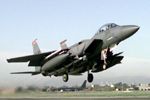
original at www.af.mil |
Desert aircraft on duty
(U.S. Air Force Photo by Staff Sgt. Vincent Parker)
INCIRLIK AIR BASE, Turkey (AFPN) - An F-15E Strike Eagle takes off from the flightline at Incirlik Air Base, Turkey, Dec. 30 during a sortie in support of Operation Northern Watch. |

original at www.af.mil |
F-15E Strike Eagle flies Northern Watch mission
(U.S. Air Force photo by Staff Sgt. Vince Parker)
An F-15E Strike Eagle flies through the clouds over eastern Turkey in support of Operation Northern Watch. The F-15E is deployed to Incirlik Air Base, Turkey, from the 48th Fighter Wing at RAF Lakenheath, England. The aircraft are helping enforce the no-fly zones over northern Iraq. (990104-F-6082P-003) |

original at www.af.mil |
52nd Fighter Wing F-15C
(U.S. Air Force photo by Senior Master Sgt. Rose Reynolds)
A Spangdahlem Air Base Germany F-15C flys a training mission. The 52nd Fighter Wing is the largest fighter operation and most versatile wing of the U.S. Air Forces in Europe, with four fighter squadrons and an air control squadron. The 52nd expanded considerably in 1994 when it annexed nearby Bitburg Air Base. Major combat units include the 22nd Fighter Squadron, 23rd Fighter Squadron, 53rd Fighter Squadron and 81st Fighter Squadron. Aircraft assigned include the F-15 Eagle, A-10/OA-10 Thunderbolt II and F-16 Falcon. |

original at www.af.mil |
F-15C banks hard right
(U.S. Air Force photo by Fernando Serna)
The F-15 Eagle is an all-weather, extremely maneuverable, tactical fighter designed to permit the Air Force to gain and maintain air superiority in aerial combat. The Eagle's air superiority is achieved through a mixture of unprecedented maneuverability and acceleration, range, weapons and avionics. It can penetrate enemy defense and outperform and outfight any current enemy aircraft. The F-15 has electronic systems and weaponry to detect, acquire, track and attack enemy aircraft while operating in friendly or enemy-controlled airspace. The weapons and flight control systems are designed so one person can safely and effectively perform air-to-air combat. The F-15's superior maneuverability and acceleration are achieved through high engine thrust-to-weight ratio and low wing loading. Low wing-loading (the ratio of aircraft weight to its wing area) is a vital factor in maneuverability and, combined with the high thrust-to-weight ratio, enables the aircraft to turn tightly without losing airspeed. |
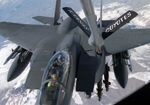
original at www.af.mil |
F-15E refueled by KC-135
(U.S. Air Force photo by 1st Lt. Dave Westover)
An F-15E from the 492nd Expeditionary Fighter Squadron is refueled March 14 by a KC-135 from the 190th Expeditionary Air Refueling Squadron. The deployed units are part of Operation Northern Watch here and tasked with enforcing the northern Iraq no-fly zone. The 492nd EFS is based at Royal Air Force Lakenheath, England, and the 190th is an Air National Guard unit based in Topeka, Kan. Coalition aircraft have been enforcing the northern no-fly zone for nearly eight years. Since Dec. 28, Saddam Hussein has challenged this enforcement by targeting coalition aircraft with radar, surface-to-air missile systems and antiaircraft artillery. |
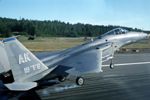
original at www.af.mil |
An Elmendorf AFB, Alaska, F-15C lands
(U.S. Air Force photo by Master Sgt. Dave Nolan)
The F-15 Eagle is an all-weather, extremely maneuverable, tactical fighter designed to gain and maintain air superiority in aerial combat.The Eagle's air superiority is achieved through a mixture of unprecedented maneuverability and acceleration, range, weapons and avionics. It can penetrate enemy defense and outperform and outfight any current or projected enemy aircraft. The F-15 has electronic systems and weaponry to detect, acquire, track and attack enemy aircraft while operating in friendly or enemy-controlled airspace. Its weapons and flight control systems are designed so one person can safely and effectively perform air-to-air combat. The F-15's superior maneuverability and acceleration are achieved through high engine thrust-to-weight ratio and low wing loading. Low wing-loading (the ratio of aircraft weight to its wing area) is a vital factor in maneuverability and, combined with the high thrust-to-weight ratio, enables the aircraft to turn tightly without losing airspeed. |
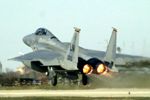
original at www.af.mil |
Combat success tied to training, technology, NATO structure
(U.S. Air Force Photo by Airman 1st Class Joseph Lozada)
An F-15 assigned to the 493rd Fighter Squadron, Royal Air Force Lakenheath, England, takes off from Cervia Air Base, Italy.The 493rd FS deployed to Cervia to support air strike operations in the Federal Republic of Yugoslavia. |
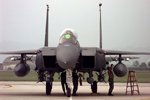
original at www.af.mil |
Allied Force - F-15E Strike Eagle post-flight check
(U.S. Air Force photo by Senior Airman Jeffrey Allen)
Airmen of the 494th Fighter Squadron Royal Air Force Lakenheath, England, perform post-flight checks on an F-15E Strike Eagle on Wednesday, May 12, 1999, at Aviano Air Base, Italy. The F-15E is returning from an NATO Operation Allied Force mission. The 494th is deployed to Aviano for Allied Force. |

original at www.af.mil |
F-15E Strike Eagle fires AGM-65 Maverick
(U.S. Air Force Photo by Senior Master Sgt. Derek Harris)
An AGM-65 Maverick missile leaves the rail of an F-15E from the 422nd Test and Evaluation Squadron, Nellis Air Force Base, Nev., before hitting its target on the Utah Test and Training Range. This live-fire mission was part of the Y2K Flag operational assessments being conducted in conjunction with the air-to-ground Weapons System Evaluation Program. |

original at www.af.mil |
Capturing the Moment
(U.S. Air Force photo by George Rolhmaller)
Steve Zapka, an aerial photographer with the Edwards Air Force Base, Calif., audiovisual services center, steadies a high-speed film camera in the rear of an F-15 Eagle from the 445th Flight Test Squadron. |
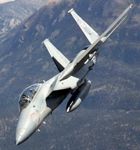
original at www.af.mil |
An eagle soars in the mountains
(U.S. Air Force Photo by George Rolhmaller)
EDWARDS AIR FORCE BASE, Calif. (AFPN) -- An F-15 Eagle from the 445th Flight Test Squadron here banks over mountains in the Sequoia National Forest. The F-15 was flying as a chase aircraft during recent B-1B bomber tests. Throughout the years, Edwards has evaluated the world's current premier air superiority fighter for engine enhancements, radar improvements and weapons additions. |
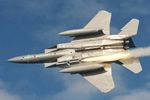
original at www.af.mil |
F-15A "Eagle" launches an AIM-7
(U.S. Air Force Photo by Staff Sgt. Matthew C. Simpson)
F-15A "Eagle" of the 110th Fighter Squadron, 131st Fighter Wing, Air National Guard, Lambert-St. Louis IAP, Mo., launches an AIM-7 "Sparrow" missile, during a Weapons System Evaluation Program. The F-15's superior maneuverability and acceleration are achieved through high engine thrust-to-weight ratio and low wing loading. Low wing-loading (the ratio of aircraft weight to its wing area) is a vital factor in maneuverability and, combined with the high thrust-to-weight ratio, enables the aircraft to turn tightly without losing airspeed. The AIM-7 Sparrow is a radar-guided, air-to-air missile with a high-explosive warhead. The versatile Sparrow has all-weather, all-altitude operational capability and can attack high-performance aircraft and missiles from any direction. |

original at www.af.mil |
Strike Eagle jet engine change
(U.S. Air Force Photo by Senior Airman Tony R. Tolley)
Crew Chiefs from the 48th Fighter Wing, 494th Fighter Squadron, Royal Air Force Lakenheath, United Kingdom, pull out a Pratt & Whitney F100-229 engine from a F-15E Strike Eagle. The two engines produce 58,000 pounds of thrust (29,000 each). With incorporated advanced digital technology for improved performance the F-15E pilots can accelerate from idle power to maximum afterburner in less than four seconds. Faster engine acceleration means quicker takeoffs and crisper response while maneuvering. |
^^ TOP ^^
|

